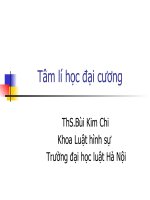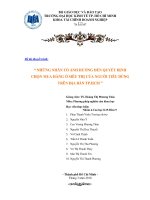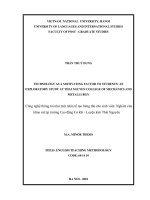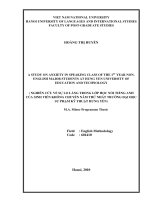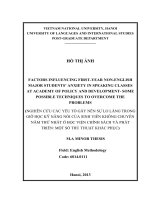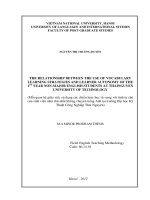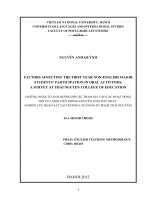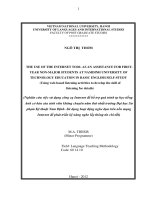Những nhân tố ảnh hưởng đến sự tham gia vào các hoạt động nói của sinh viên không chuyên năm thứ nhất nghiên cứu khảo sát tại trường Cao đẳng Sư phạm Thái Nguyê
Bạn đang xem bản rút gọn của tài liệu. Xem và tải ngay bản đầy đủ của tài liệu tại đây (1.06 MB, 54 trang )
VIETNAM NATIONAL UNIVERSITY, HANOI
UNIVERSITY OF LANGUAGES AND INTERNATIONAL STUDIES
FACULTY OF POST-GRADUATE STUDIES
----------
NGUYỄN ANH QUỲNH
FACTORS AFFECTING THE FIRST YEAR NON-ENGLISH MAJOR
STUDENTS’ PARTICIPATION IN ORAL ACTIVITIES:
A SURVEY AT THAI NGUYEN COLLEGE OF EDUCATION
(NHỮNG NHÂN TỐ ẢNH HƯỞNG ĐẾN SỰ THAM GIA VÀO CÁC HOẠT ĐỘNG
NĨI CỦA SINH VIÊN KHƠNG CHUN NĂM THỨ NHẤT :
NGHIÊN CỨU KHẢO SÁT TẠI TRƯỜNG CAO ĐẲNG SƯ PHẠM THÁI NGUYÊN)
M.A MINOR THESIS
FIELD: ENGLISH TEACHING METHODOLOGY
CODE: 601410
HANOI-2012
1
TABLE OF CONTENTS
Contents
Page
DECLARATION ...........................................................................................
i
ACKNOWLEDGEMENTS ............................................................................
ii
ABSTRACT ...................................................................................................
iii
TABLE OF CONTENTS ................................................................................
iv
LIST OF ABBREVIATIONS..........................................................................
vii
LIST OF FIGURES AND TABLES ................................................................
viii
Part A: INTRODUCTION ..........................................................................
1
1. Statement of problem and rationale.............................................................
1
2. Aims of the study .......................................................................................
2
3. Significance of the study ............................................................................
2
4. Scope of the study ......................................................................................
3
5. Research methods ......................................................................................
3
6. Organization of the study ...........................................................................
3
Part B: DEVELOPMENT ...........................................................................
5
CHAPTER 1: LITERATURE REVIEW ....................................................
5
1.1. Theoretical background of speaking ....................................................
5
1.1.1. Concept of speaking .............................................................................
5
1.1.2. The role of speaking in foreign language teaching ................................
6
1.1.3. Approaches in teaching speaking ..........................................................
6
1.2. Students’ participation in oral activities .............................................
8
1.2.1. Concept of students’ participation .........................................................
8
1.2.2. Factors affecting students’ participation in oral activities ......................
8
8
1.2.2.1. Students’ factors ..............................................................................
1.2.2.1.1. Students’ language proficiency level ...............................................
8
1.2.2.1.2. Students’ personally factors ............................................................
9
1.2.2.1.3. Students’ attitude and motivation ....................................................
10
11
1.2.2.2. Teachers’ factors .............................................................................
1.2.2.2.1. Teachers’ teaching method .............................................................
11
1.2.2.2.2. Teachers’ knowledge and characteristics ........................................
12
12
1.2.2.3. Classroom factors .............................................................................
1.2.2.3.1. Classroom size ................................................................................
12
1.2.2.3.2. Classroom atmosphere ....................................................................
13
1.2.2.3.3. Classroom physical conditions ........................................................
13
1.3. Relevance of this study ..........................................................................
14
CHAPTER 2: METHODOLOGY .............................................................
15
2.1. Background of the study .......................................................................
15
15
2.1.1. An overview of Thai Nguyen College of Education ..............................
15
2.1.2. The teachers .........................................................................................
15
2.1.3. The students .........................................................................................
16
2.1.4. The materials and syllabus ...................................................................
2.1.5. Classroom facilities .............................................................................16
2.2. Research questions ................................................................................
17
2.3. The participants ....................................................................................
17
2.4. Data collections instruments .................................................................
17
17
2.4.1. Survey questionnaires ...........................................................................
18
2.4.2. Interviews .............................................................................................
2.5. Data collection procedures ....................................................................
18
CHAPTER 3: RESULTS AND DISCUSSION ...........................................
19
3.1. Data analysis ..........................................................................................
19
19
3.1.1. Results of students’ survey questionnaire ............................................
26
3.1.2. Results of teachers’ survey questionnaire............................................
31
3.1.3. Result from interviews with teachers.....................................................
3.2. Findings and discussion ........................................................................
34
34
3.1.1 Students’ low level of participation in oral activities ............................
35
3.2.2. Students’ factors .................................................................................
35
3.2.3. Teachers’ factors ..........................................................................
36
3.2.4. Classroom factors ................................................................................
36
3.2.5. Material factors....................................................................................
3.3. Conclusion .............................................................................................
37
CHAPTER 4: IMPLICATIONS AND RECOMMENDATIONS .............
38
4.1. The students ............................................................................................
38
4.2. The teachers ............................................................................................
38
4.3. The classroom .........................................................................................
40
Part C: CONCLUSION ...............................................................................
41
1. Summary of the study.................................................................................
41
2. Limitation and suggestions for further study...............................................
42
REFERENCES.............................................................................................
43
APPENDICES
LIST OF ABBREVIATIONS
TNCE: Thai Nguyen College of Education
CLT:
Communicative Language Teaching
EFL:
English as Foreign Language
ESL:
English as Second Language
LIST OF FIGURES AND TABLES
Figure 1.........................................................................................................19
Figure 2.........................................................................................................20
Figure 3.........................................................................................................21
Figure 4.........................................................................................................21
Table 1 ..........................................................................................................19
Table 2 ..........................................................................................................22
Table 3 ..........................................................................................................23
Table 4 ..........................................................................................................24
Table 5 ..........................................................................................................24
Table 6 ..........................................................................................................25
Table 7 ..........................................................................................................26
Table 8 ..........................................................................................................27
Table 9 ..........................................................................................................28
Table 10 ........................................................................................................29
Table 11 ........................................................................................................30
Part A: INTRODUCTION
1. Statement of problem and rationale
Undeniably, in learning English, the four skills namely reading, writing, speaking,
listening are very important but speaking seems to be the most significant. Any
learners of English want to achieve this skill. However, speaking is generally
considered the most demanding of the four skills (Bailey and Savage, 1994: vii). For
this reason, being aware of the necessity of speaking, English teachers though trying
to improve all four skills, always pay much attention on speaking for their students.
However, the teaching and learning of English speaking skill in Vietnam has
encountered many difficulties. For Vietnamese learners, speaking is a very difficult
skill. It takes learners lots of time practicing if they want to be skillful at it. In fact
although most of Vietnamese learners pay much attention to grammatical structures
and vocabulary, they are often reluctant in speaking skill.
In recent years, English teachers have changed their teaching methods and focused
their teaching on speaking to the students. One top concern of almost all teachers is
students’ ineffective participation in speaking lessons. The reasons for that are
various. Tsui (1996), after carrying a research in Hong Kong, lists five principle
factors affecting the reluctance of students’ participation in classroom speaking
lessons: students’ perceived low proficiency in English, students’ fear of making
mistakes and derision, teachers’ intolerance of silence, uneven allocation of turns,
incomprehensible input (as cited in Nunan, 1999: 234).
In Vietnam, Phung (2006) conducts an experiment about techniques to overcome
factors affecting the participation in classroom oral activities at College of Social
Sciences and Humanities. The findings shows that factors affecting his students’
participation includes students’ learning styles, motivation, language level, gender
differences, teachers’ teaching techniques, characteristics, teachers’ knowledge,
implementation of teachers’ role in speaking activities, the available facilities and
classroom atmosphere.
Nguyen (2010) suggests strategies to increase the participation in communicative
activities of students at Dong Do high school, Hanoi. She also concludes that the
factors affecting her students’ participation in communicative activities are students’
poor background knowledge, lack of confidence, lack of motivation and passive
learning style.
Although there have been many studies about factors affecting students’
participation in oral activities, it is considered new in the EFL context of Thai
Nguyen College of Education (TNCE). As a teacher at this college, the
researcher sees that most of her students do not often enjoy speaking period, and
they do not actively contribute the speaking lessons. They always keep quiet,
passively take note, some listen to better students speaking but do nothing, and some
hard-working students discuss in Vietnamese. The study entitled “ Factors
affecting the first year non-English major students’ participation in oral activities:
a survey at Thai Nguyen College of Education” is an attempt to find out the reasons
for above problems, and give some suggestions to increase students’ participation in
oral activities.
2. Objectives of the study
The study was conducted to (1) investigate the current teaching and learning of
speaking skill of the students at TNCE, (2) identify the factors affecting the first
year non-English major students’ participation in oral activities, then (3) give some
recommendations for teachers and students to increase students’ participation in oral
activities.
3. Significance of the study
Theoretically, it is hoped that this study can be used as a reference for other
researchers who want to conduct the study related to teaching and learning speaking
in general and factors affecting students’ participation in oral speaking activities in
particular. The result of the study can be useful for English teachers to implement
suitable teaching method to their students.
Practically, the study will hopefully better the researcher and her colleagues’
teaching, help the students be aware of their problems in learning and solve these
problems. The researcher also hopes that this study will benefit both the teaching
and learning of English speaking.
4. Scope of the study
The current research mainly covers the possible factors affecting the students’
participation in oral activities including students’ language proficiency level,
attitude and motivation, personality, teacher’ s teaching methods, characteristics,
classroom size, atmosphere, and materials. The subjects of the study are 6 teachers
of English and 160 first year non-major English students at TNCE
5. Research methods
To conduct the study, quantitative and qualitative methods were used. To collect
information and evidence for the study, survey questionnaires for both teachers and
students and interviews for teachers were used. All comments, remarks,
recommendations and conclusion provided in the study based on the data analysis.
6. Organization of the study
This minor thesis is composed of three parts:
Part A, Introduction, presents the statement of problem and rationale, aims of the
study, significance of the study, scope of the study, research methods, and
organization of the study.
Part B, Development, including the following chapters:
Chapter 1, Literature review, presents the theoretical background of speaking in
which concept of speaking, the role of speaking in foreign language teaching and
learning, approaches in teaching speaking are considered, issues of students’
participation in oral activities including concept of students’ participation and
factors affecting students’ participation in oral activities.
Chapter 2, Methodology, includes background of the study, research questions, the
participants, data collection instruments, and data collection procedures.
Chapter 3, The results and discussions, presents data analysis of the study, findings
and discussions which discover factors affecting both students and teachers in oral
activities
Chapter 4, Implications and Recommendations, gives some suggestions to increase
students’ participation in oral activities.
Part C, Conclusion, summarizes all the key issues of the study as well as the
limitations of the study and suggestions for further study.
Part B: DEVELOPMENT
CHAPTER 1: LITERATURE REVIEW
This chapter consists of three sections. The first section reviews the theoretical
background of speaking which includes the concept of speaking, the role of
speaking in foreign language teaching and learning, approaches in teaching
speaking. The second section deals with the issues of students’ participation in oral
activities. The last section is the relevance of this study.
1.1. Theoretical background of speaking
1.1.1. Concept of speaking
In language teaching, speaking can be regarded as the productive skill. Different
linguists have different concepts of speaking. According to Chaney and Burk
(1998:13), speaking is “the process of building and sharing meaning through the use
of verbal and non-verbal symbols in a variety of contexts”. As stated by Burn and
Joyce (1997), speaking is an interactive process of constructing meaning that
involves producing and receiving and processing information. Moreover, speaking,
as Bygate (1987) defines, involves not only the use of the right sounds in the
patterns of rhythm and intonation, but also the choice of words and inflections in the
right order to convey the right meaning.
In the study of Brown and Yule (1983), spoken language consists of short,
fragmentary utterances in a range of pronunciation. Besides, speaking is known to
have two main types of conversation namely dialogue and monologue. In
monologue, you give uninterrupted oral presentation while in dialogue you interact
with one or more other speakers for transactional and international purposes.
From the above definitions, speaking is making use words, knowing and being able
to use language; expressing in words and making speech. Therefore, we can infer
that speaking is the ability to make use of words or a language to express oneself in
actual communication.
1.1.2. The role of speaking in foreign language teaching and learning
It has been accepted for many years that communication is the proper aim for
language teaching. According to Hymes (1972) “ The goal of language teaching is to
develop communicative competence” (as cited in Larseen-Freeman, 1986). That
means we learn a language to communicate well in that language. In the study of Ur
(1996), speaking seems intuitively the most important of all four skills. Speaking is
regarded as the first step to confirm who knows or does not know a language. Abbot
(1981) remarks that just as the proof of the pudding is in the eating, so the proof of
language-learning lies in the learner's ability to perform, communicate in the foreign
language. Pattison (1992) shared the same opinion that when people mention
knowing or learning a language, they actually mean that they are able to speak the
language.
For that reason, speaking skill plays an important role in foreign language teaching
because effective speaking ability helps learners not only to acquire the language
better but also to communicate successfully. In the language classroom, speaking
skill should be paid great attention to.
1.1.3. Approaches in teaching speaking
There are several approaches in teaching English speaking such as GrammarTranslation Method, Direct Method, Audio-Lingual Approach, and a more modern
approach, namely Communicative Language Teaching Approach (CLT). However,
in recent decades, CLT mostly employ on the belief that helps to develop the
learners’ communicative language ability. Therefore, in this section, the researcher
only discuss on CLT as an approach for teaching speaking skill.
Many researchers say that CLT has prevailed over traditional methods such as
grammar translation method or the audio-lingual method. This is due to several
reasons. According to Mitchell (1994), CLT covers the four skills of the language
which are listening, reading, speaking, and writing (receptive and productive skills),
which can be lacking in certain methods like grammar translation method or the
audio-lingual method. Today, communicative language teaching is viewed as the
most effective and widely used approach in EFL/ESL teaching, most modern
methods and techniques emphasize it (Kumaravadivelu 1993; Savignon 2000), and
most materials and textbooks are designed for it.
Moreover, Savignon (2000: 126-128) says that the essence of CLT is the
engagement of learners in communication to allow them to develop their
communicative competence. He also emphasized that the focus of CLT is to
promote the development of functional language ability through learner
participation in communicative events. A further definition of CLT is explicitly
characterized by Li (1998:679) as follows: A focus on communicative function; A
focus on meaning tasks rather than on language per se (e.g. grammar or vocabulary
study); Efforts to make tasks and language relevant to a target group of learners
through an analysis of genuine, realistic situation; the use of authentic, from life
materials; the use of group activities; and the attempt to create a secure, non
threatening atmosphere.
CLT is learner-centered and emphasizes communication and real-life situations.
Therefore, the role of the teacher and the students in CLT is quite different from
traditional teaching methods. In the traditional classroom, the teacher is in charge
and "controls" the students. In CLT the teacher serves as more of a facilitator,
allowing students to be in charge of their own learning. According to LarsenFreeman (1986), teachers in communicative classroom talk less and listen more.
The teachers set up the exercise, then step back and observe, sometimes act as a
monitor. In contrast, the students do most of the speaking. Because of the increased
responsibility to participate in communicative activities, students may find they gain
confidence in using the target language in general. Students are more responsible
managers of their own learning.
In conclusion, among some approaches of the language teaching methods, CLT is
the most appropriate way to teach students to communicate. Therefore, the
researcher decides to choose CLT as an approach for teaching speaking skill and
considers it as one of the bases of the study.
1.2. Student’ s participation in oral activities
1.2.1. Concept of students’ participation
Students’ participation can be understood as students’ involvement in classroom
activities and in this case, oral activities. According to Howard, Short, and Clark
(1996: 8-24) participation is the student’ s active engagement in the classroom to
promote effective learning. The student’ s activities may include reciting in
class, having conversations with the instructor or their classmates, doing
written outputs, and sharing ideas with others. It means a participative learner is
one that is not passive. Moreover, Sylvelyn, Judith and Paulin (2009) define
participation as students who actively engage in classroom discussions, rather
than be passive learners who simply take in knowledge. They affirm that in a
classroom-based learning, participation can be a positive feedback given by
students to either the lesson or the teacher which can lead to possible ways in the
development of an improved classroom learning experience.
1.2.2. Factors affecting students’ participation in oral activities
Students’ participation in oral activities can be affected by a variety of factors
originating from students, teachers and classroom. In the following sections, some
of the major factors will be discussed.
1.2.2.1. Students’ factors
1.2.2.1.1. Students’ language proficiency level
It is undeniable that students’ language proficiency is one important factor affecting
students’ participation in oral activities. According to Rod (1985) proficiency
consists of the learners’ knowledge of target language; it can be synonymous with
“ competence” .
Proficiency
can
be
viewed as linguistic competence
or
communicative competence. Second language proficiency is usually measured in
relation to native speaker proficiency. Moreover, Stern (1992) defines proficiency
in terms of objectives or standards. These can serve as criteria by which to assess
proficiency as an empirical fact that is the actual performance of given individual
learners or group of learners.
Language proficiency ranges from Beginning to Fully-English Proficient. However,
historically, few students achieve Fully-English Proficient.
In fact, in a class if students’ language proficiency is rather low, they will not be
confident to participate in speaking lesson. Moreover, if students’ language
proficiency level are low or students are of different language proficiency levels,
teachers may cope difficulties choosing a suitable teaching method, and activities
used in class.
To conclude, the limitation in the students’ language proficiency levels can directly
affect their participation, how much they like the activities. Thus, in order to develop
their second language proficiency, students should try their best to overcome all
their difficulties, practice English as mush as possible and teachers should choose
the topics and activities of students’ levels to encourage their participation.
1.2.2.1.2. Students’ personality factors
It is obvious that personality has a great influence on students’ participation in
speaking lesson. Participation usually means students speaking in class: answer and
ask questions, make comments, and join in discussions, etc. Students who do not
participate in those ways mentioned above are often considered to be passive and are
generally penalized when participation is graded. Brown (2000) argues that
personality is one of the affective factors that are equally important for explaining
differential success among second language learners. Personality may be divided
into extroversion and introversion. While extroversion is associated with risk-taking,
introversion is subsumed under the concept of self-esteem.
A study conducted by Galvan and Fukada (1997/1998: 29-49) finds that students
who are outgoing participated more than introverts. The study also determine that
participants who self-reported as having passive personalities are least likely to
initiate a question or volunteer an answer to teacher’ s question. Additionally,
knowledge of personal preferences can help teachers and administrators understand
and predict student performance so they can restructure the situation to facilitate
more students’ participation. Moreover, as stated by Barrett and Connot (1986: 39-
45), introverted students are least involved in school activities and have lower
academic achievement. As Carskadon (1978: 140-142) states, extroverts generally
produce more action with fewer thoughts whereas introverts produce numerous
thoughts with little action.
To sum up, in a class students with different personality characteristics may result in
different level of participation in lessons and different of level of success as well.
Understanding of students’ personality will help teachers choose the suitable
method to involve all students in oral activities.
1.2.2.1.3. Students’ attitude and motivation
Besides, students’ attitude and motivation is also a very important factor. Gardner
(1985:10) defined that “ motivation in the present context refers to the combination
of effort plus desire to achieve the goal of learning the language plus favorable
attitudes towards learning the language” . In other words, motivation can be defined
in terms of two factors: learners’ communicative need and their attitudes towards
the second language community (Lightbrown and Spada, 1999:56). In language
learning, motivation is considered as “ a key consideration in determining the
preparedness of learners to communicate” (Gardner, 1985:10). He also indicates that
the motivation of foreign language learning contains four aspects: a goal, effortful
behavior, a desire to attain the goal and the attitude. It can be understood that if
students have strong learning motivation take positive attitude towards study and
make great efforts to master English with clear goal and desire, they will gain better
grade than those who have not acquired motivation.
According to (Sass, 1989: 86-88) there are many factors affecting student's
motivation to work and to learn: interest in the subject matter, perception of its
usefulness, general desire to achieve, self-confidence and self-esteem, as well as
patience and persistence. And, of course, not all students are motivated by the same
values, needs, desires, or wants. Some students will be motivated by the approval of
others, some by overcoming challenges.
Dornyei (2001), Oxford and Shearin (1994: 19) suggests some ways that teachers
can do to increase students’ motivation in English speaking activities: capitalize on
students’ existing needs, help students set achievable goals, give clear explanation,
create a comfortable atmosphere, vary teaching activities and methods, make
learning visual, increase students’ self-confidence, promote co-operative learning,
make students active participants in speaking activities, respond to students’ work
and reward success.
In brief, motivation plays a very important role in teaching and learning as “ positive
attitudes and motivation are related to success in second language learning”
(Gardner, 1985). Whatever factors affecting students’ motivation, it is a duty for
each language teacher to increase students’ motivation in speaking lesson.
1.2.2.2. Teachers’ factors
1.2.2.2.1. Teachers’ teaching method
Teachers’ teaching methods refer to a set of techniques or activities used to get
students involved in learning to achieve a goal. It means that teachers’ teaching
techniques or activities can either motivate or demotivate students to learn.
Harmer (1991:12) finds that classes in which the teachers present a variety of
activities are far more likely to ensure students’ continuing interest and involvement
in learning, whereas classes in which the teachers continually give the same
activities are not likely to engage students’ interest. Furthermore, students
considerably vary in personality, preferences and beliefs. The activity that is
particularly appropriate for one student may not be ideal for another. Thus, a
particular teaching method cannot satisfy the needs or the interests of all students.
To summarize, there is no single teaching method that is suitable for all learners. All
these teaching and learning methods are to be used interchangeably. According to
Le (2000) Vietnamese students’ passiveness in learning is the product of traditional
teaching. Therefore, teachers should use a variety of teaching and learning methods
in a single period so as to provide a great variability of activities in the teaching and
learning process to increase students’ involvement.
1.2.2.2.2. Teachers’ knowledge and characteristics
Teachers’ knowledge and characteristics are widely believed to impact on students’
involvement in the lessons. In the study “ What makes a good teacher” , Breach
(2005: 30-37) points out that most students believe that the teacher is the fountain of
knowledge and their main responsibility is to pass on that knowledge to students. A
good teacher of English is a person who is supposed to have language ability,
specialist knowledge and general knowledge of an English speaking country.
Moreover, teachers should have some key characteristics that they need to excel in
their job. Barry (1993) mentions that teachers should be natural, warm, pleasant,
approachable, tolerant. This means that teachers should create close relationship
with their students. This relationship has a great value in creating pleasant
atmosphere in class reducing students’ anxiety and stress in learning and enhancing
students’ participation in the activities.
In summary, not all teachers have all those factors. However, teachers should try to
renovate their teaching method, improve knowledge, and create a close relationship
with students to encourage students to participate in speaking activities.
1.2.2.3. Classroom factors
1.2.2.3.1. Classroom size
The number of students is an important factor in foreign language classes. In Hayes’
definition (1997), any class with over 40 students can be considered a large class.
Teaching large classes is difficult for both teachers and students in many reasons.
First, teaching large classes requires more work for the teacher as there are more
learners to assist. Then, it is not easy for teachers to motivate all students, make all
of them concentrated, to have them involved, and to get them promptly responded.
Moreover, large classes are often more difficult to control because of the number of
learners. Noise is greater, and discipline problems are more likely to become
uncontrollable. Next, many of techniques and materials we use in smaller classes
are difficult to use with larger classes because of students’ different learning
preferences, different English proficiency level. If there is little classroom space, for
example, arranging seats in groups can be difficult or impossible.
In short, large classes cause problems for both teachers and students. Therefore both
teachers and students have responsible to reduce those problems to have effective
lessons. Students should actively participate in the lessons. Teachers should choose
suitable method or techniques to involve all students, such as group work, pair work,
etc.
1.2.2.3.2. Classroom atmosphere
Many teachers do not take the atmosphere of a classroom into consideration when
they conduct their classes, but the atmosphere is an essential part of learning in a
classroom. Creating a positive and engaging classroom atmosphere is one of the
most powerful tools teachers can use to encourage students’ learning and prevent
problem behaviors from occurring. Language learning is considered one of the most
face-threatening school subjects. Language anxiety has been found to be a powerful
factor that hinders students’ participation in oral activities. In order to get learners
more involved in class, especially in speaking activities, a favorable classroom
atmosphere is considered indispensable. According to Underwood (1987:34-44),
both teachers and students should create a pleasant teaching and learning
atmosphere.
In brief, as a teacher, it is important to make sure the classroom atmosphere is
comfortable in order to ensure productivity.
1.2.2.3.3. Classroom physical conditions
Classroom physical conditions refer the lightness/ brightness, the temperature and
fresh air, the acoustics, the lines of vision, the layout of the desks or tables, the
possibility of moving desks or tables, the other furniture, and the facilities for
displaying pictures, charts, etc. (Unnderwood, 1987). Classroom physical conditions
also have great impact on students’ learning as well as their attitude towards the
subject matter. These conditions affect students’ motivation either positively or
negatively.
L2 teachers should be reminded that the classroom is not only a psychological
environment but also a physical condition. The decoration: posters, flowers, funny
objects influence strongly the classroom atmosphere. More importantly, teachers
should create the ownership of the class among students. (Dornyei, 2001:42) stated
“ Personalizing the classroom can be seen as students exercising increasing control
over their environment”
1.3. Relevance of this study
The above mentioned discussion of related study serves to demonstrate how the
present research could fit into the existing literature. So far, a number of studies
have elaborated various factors that affect students from participating in oral
activities. With the hope to find out the factors affecting the participation of students
in oral activities, the researcher will consider some main factors to see if they affect
her students’ participation in oral activities. Those factors are students’ language
proficiency level, personality, attitude and motivation, teachers’ teaching method,
characteristics, classroom size, atmosphere, physical conditions and materials.
This chapter has provided both selected theoretical background of speaking, and
issues of students’ participation in oral activities, accompanied by the relevance of
the present study. The research methodology employed in the present study will be
presented in the next chapter.
CHAPTER 2: METHODOLOGY
In this chapter, the methods for carrying out the study will be discussed. These
include background of the study, research questions, the participants, data
collection instruments and data collection procedures.
2.1. Background of the study
2.1.1. An overview of Thai Nguyen College of Education
Thai Nguyen College of Education, established in 1968, is one of the leading
colleges in Thai Nguyen. It is famous for its tradition of good teaching and learning.
Thousands of primary, lower secondary teachers are trained every year to meet the
need of human resources for Thai Nguyen province and some others provinces in
the north of Vietnam. The college has about 2000 students and more than 200
officials and teachers of all subjects.
2.1.2. The teachers
There are 6 English teachers at TNCE, who are all enthusiastic to devote their time
and energy to teaching. All of them graduated from Thai Nguyen Teacher Training
University. Four of them have acquired an M.A. degree and two of them are
following an M.A course at Hanoi University of Foreign Languages and
International Studies. They are all young with the age ranging from 28 to 38 and
have at least 4 years of experience in teaching English. Half of them get the award
for one of the best teachers in Thai Nguyen in many years. They are so well-aware
of the important role of the ability to communicate in English. Therefore, they pay
much attention to form students’ ability of speaking and they always try to find out
effective teaching methods to increase teaching and learning quality.
2.1.3. The students
Most of the students at TNCE have been learning English since they were at grade
6, even at grade 3. However, when they come to college, they know very little
English. The main training fields at TNCE are primary, lower secondary school
teachers of all subjects except English. Therefore, English, as a non-major subject,
is not paid proper attention. They do not devote themselves to study English. Many
students do not have an obvious communicative need. All they need is to get enough
knowledge of grammar and vocabulary to pass the written exam. Generally, most of
the students are passive in learning English, especially in speaking lessons. English
is a very difficult subject for them. Thus, it would be hard to create, and involve
students in a communicative activity.
2.1.4. The materials and syllabus
The English book used for all students at TNCE is “ Lifelines Elementary” (Tom
Hutchinson, Oxford University Press, 2002). There are 14 units lasting 150
periods divided in three terms. Each week students have 3 or 4 English periods and
they continuously learn in 15 weeks. The book provides students with general
knowledge classified into 5 main parts: grammar, vocabulary, reading and writing,
listening and speaking, and pronunciation. The aim of the book is to enable the
students communicate in the target language. However, at TNCE, the tests and
examinations are in written form. So the teachers and students focus most of
activities on grammar, and reading comprehension to help students pass the exam.
2.1.5. Classroom facilities
At TNCE, English teaching and learning are mostly carried out inside the
classrooms, which are designed for lectures. All the seats are arranged in fixed rows
and classroom equipment is just a chalkboard. Besides, each English teacher is
provided with a cassette player to support the listening lessons. There are 8
classrooms which are equipped with projectors for all teachers at TNCE. The
numbers of such classrooms do not meet the demand of all teachers in the college.
There are not enough rooms if many classes want to use them at the same time. At
TNCE, there is no language lab. Besides, equipments and facilities are inadequate
such as lack of TV set, videotape, laboratory, headphone/microphone and projector.
The materials for reference and self-study are not enough. In the library, English
books, newspapers and magazines, which are good sources of current target
language, are not available. This is a big disadvantage for both teachers and students
who want to seek for reference materials for further study.
2.2.
Research questions
This study determined the factors affecting the first year non-English major
students’ participation in oral activities at Thai Nguyen College of Education and
gives some solutions to in crease students’ participation. The research was
implemented to answer these questions:
1. How do the students participate in oral activities?
2. What are the factors affecting the first year non - English major students’
participation in oral activities?
3. What should be done to increase students’ participation in oral activities?
2.3. Participants
The participants of the study were 160 first-year non-English major students and six
English teachers at TNCE. These students were from four classes: officemanagement K3, chemistry-biology K17, literature-geography K17, mathematicphysics K17, where the researcher was working as a lecturer of English. Each of
these classes has the total number of forty students. The research was conducted in
the second term of the school year. All the participants took part in the survey
questionnaires by answering all the given questions.
2.4. Data collection instruments
The instruments of the study were two questionnaires: one administered to 160
students and the other administered to 6 teachers and interviews for 3 teachers.
2.4.1. Survey questionnaires
Questionnaires were used because they helped collect large amount of information
without consuming too much time (Nunan, 1992). As a result, a set of survey
questionnaire was designed for students and teachers including both open-ended
and closed-ended questions.
The questionnaire for students consists of 10 questions with the aims of finding out
students’ opinions toward English speaking lessons, their difficulties in learning
speaking, their participation in speaking activities, the teaching methods used by
their teachers and their suggested solutions to increase students’ involvement in oral
activities. The respondents were all introduced how to complete the questionnaire
carefully first, and also expected to complete every question. To ensure the
reliability of the questionnaire, the researcher asked them not to discuss when they
finished the questionnaire.
The questionnaire for teachers consists of 8 questions, the purpose of which is to
find out teachers’ current teaching methods, their opinions about factors affecting
students’ participation in oral activities, and their suggestions to increase students’
participation in speaking class.
2.4.2. Interviews
Besides survey questionnaires, the researcher used semi-structured interviews
for teachers as a supplementary data collection method. Semi-structured interviews
were employed for reasons that they could bring the interviewer great flexibility to
focus more on remarkable points (Nunan, 1992). Three teachers were invited to the
interview and kindly requested to answer the interviewer’ s questions. The writer
took notes right at the place of the interview. Each interview included three
questions so that the researcher could base on to keep track with the objectives of
the study during the interviews. However, as the interviews went along, possible
relevant questions would be added to generate more useful details.
2.5. Data collection procedure
The researcher delivered the questionnaires to 166 participants, 6 English teachers
and 160 students. The participants were asked to complete at class in 30 minutes.
Each participant completed the questionnaire without discussion with the others.
After collecting the information from the questionnaires, she started interviews with
three teachers to get further information.
In this chapter, the background of the study, the research questions, participants,
instruments and data collection procedure are presented. In the best attempt to
build a scientific methodology, the researcher hopes to achieve a reliable and valid
data of the study.
CHAPTER 3: RESULTS AND DISCUSSION
This section analyzes the data collected for this study and discusses its findings. The
main source of data is derived from the answers of the two questionnaires for
students and teachers. After that, interviews were used to add further data. In this
section, the following results will be discussed:
3.1 Data analysis
3.1.1. Results of students’ survey questionnaire
3.1.1.1. Students’ attitude and motivation to English speaking
Question 1 and 2 are about students’ attitude towards learning the speaking skill.
The result is illustrated in the following figure:
25.0%
0.0%
27.5%
very important
important
little important
not important
47.5%
Figure 1: Students’ attitudes towards speaking skill
From the result collected in figure 1, it can be recognized that 47.5% of students
considered that speaking skill was important even very important skill in the English
learning and none of them thought that speaking was not importance at all. The
other 25% was left for valuing speaking as the little important one.
This result indicates that students at TNCE are all fully aware of the crucial role of
speaking skill in foreign language learning.
Questions
Options
Results (%)
Why do you learn English speaking?
A. because it is a compulsory subject
52.5
B. because it is interesting
13.75
C. because I like it
10
D. to have a good job in the future
Q2
15
E. Others (please specify): … … … ..… … .
… … … … …
8.75
Table 1: Students’ motivation in speaking
In response to question 2, only 13.75% of the students stated that they learn English
speaking because it was interesting, 10% studied English speaking for personal
interest, 15 % believed that English speaking was necessary for their future job,
while 52.5% claimed that they learned English speaking because it was compulsory.
Some students gave other answers: to communicate with foreigners, to listen to
songs, read books, magazines and watch movies in English, to go abroad after
graduating and to have a good certificate in English. These reasons presented for
only 8.75%.
This result reveals that a greater number of the students are not really motivated in
learning English. However, from the statistics we can see that an opposite trend that
most of the students are aware of the importance of speaking, they have low
motivation in learning speaking.
3.1.1.2. Students’
assessment about their speaking abilities and their level of
participation in speaking lessons
15.00%
0.00%
8.75%
Excellent
Good
Acceptable
43.75%
32.50%
Bad
Very bad
Figure 2: Students’ assessment of their speaking ability
The result revealed in figure 2 shows that there were no excellent students at
speaking English. The number of students with good level at speaking English skill
only made up 8.75% while 32.5% of the participants assumed that their speaking
was acceptable. More than half of them were bad (43.75%) or very bad (15%) at
speaking skill. From the results, most of the students are at low English speaking
level. Therefore, they need to improve their English speaking skill.
35
35
32.5
A. I always take every opportunity to
30
speak English.
25
20
20
15
B. I only speak if I like the topic.
C. I only speak when teacher orders me.
12.5
10
D. I rarely speak and often keep quiet in
5
speaking lessons.
0
A
B
C
D
Figure 3: Students’ level of participation in speaking activities
It can be seen from figure 3 that only 12.5% of the students always spoke English in
class, they actively took every chance to speak English. 20% only spoke if they
liked the topic, 35% only spoke if teacher ordered them. One third of them (32.5%)
rarely spoke in class. We can see that this number is not small. Many students often
kept quiet and were passively in speaking lessons. From the results shown in the
figure, a conclusion can be drawn that levels of students’ participation in oral
activities are very low. Most of students are not active in oral activities.
3.1.1.3. Students’
opinion about speaking lessons and speaking topics in their
course book
A. Boring. Most of students are quiet.
50
45
40
35
30
25
20
15
10
5
0
47.5
B. Not very interesting. Most of
students do not want to speak.
27.5
C. All right. Many students are very
active and willing to speak.
15
10
D.
A
B
C
D
Interesting.
Most
of
students
participate in speaking lessons.
Figure 4: Students’ assessment of their speaking lessons
The result in figure 4 reveals that the majority of the students found their speaking
lessons were boring (15%) or not very interesting (47.5%) and they didn’ t
participate in speaking. 27.5 % answered that their speaking lessons were all right,
many students were very active and willing to speak. Only 10 % said their speaking
lessons were interesting.
In brief, from the above result, it can be seen that students’ participation is very
limited. Teachers should do something to improve students’ involvement in
speaking lessons.
Question 6 is students’ assessment of given speaking tasks in the book “ lifelines
elementary” that they study in the first and second term.
Level of difficulty:
1. difficult
2. not very difficult
3. easy
Level of interest:
1. interesting
2. not very interesting 3. boring
